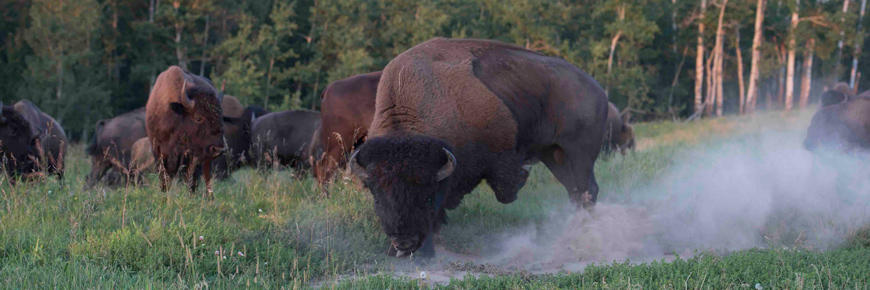
© Scott Mair
Bison frequently asked questions
Elk Island National Park
Bison are fascinating creatures. There is a lot to learn about them! Here are some of the most common questions our staff get about these animals. If you have any more questions about bison, talk to our park staff at the Visitor Centre or the Astotin Theatre!
Where can I find bison at Elk Island?
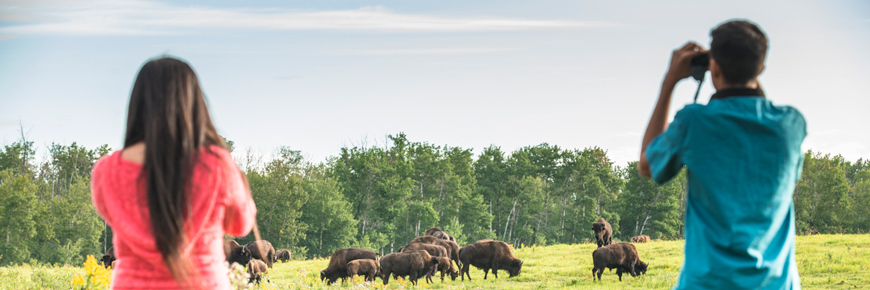
© Parks Canada / Scott Munn
Because bison are free to roam around the park, crossing paths with bison takes good timing and luck. Try the Bison Loop Road at dawn, dusk, or on overcast days. On hot, sunny days they take shelter in the forest shade, and they are most often seen on Hayburger, Tawayik, and Wood Bison Trails.
Plains bison are found north of Highway 16, and wood bison are found south of it. Remember, to stay safe and observe all wild animals from a respectful distance.
When is the best time to see bison?
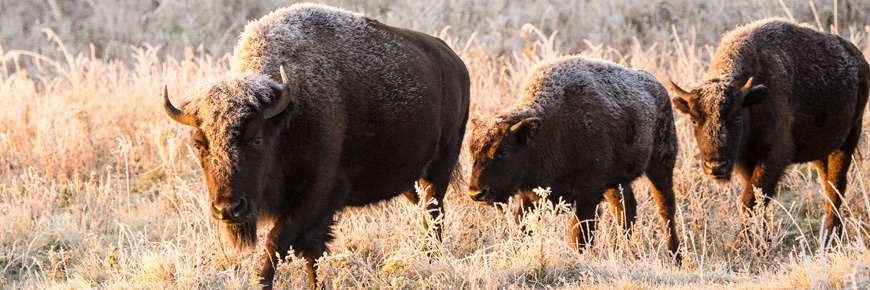
© Parks Canada / Steve Edgerton
To increase your chances of seeing bison or other large animals like moose or elk, plan your visit around dawn or dusk, or on cooler overcast days. June is an excellent month to watch frolicking baby bison, as most bison calves are born by that point in the season.
Check out the Bison Loop Road in August as much of the herd congregates there for the mating season. Bison are also more visible during the fall and winter months when they are often seen along the parkway or near the Bison Loop. You are unlikely to see bison at the Bison Loop in the middle of a hot summer day. On those days, you had better hit the trail and find some shade to track down some bison.
How many bison are there at Elk Island?
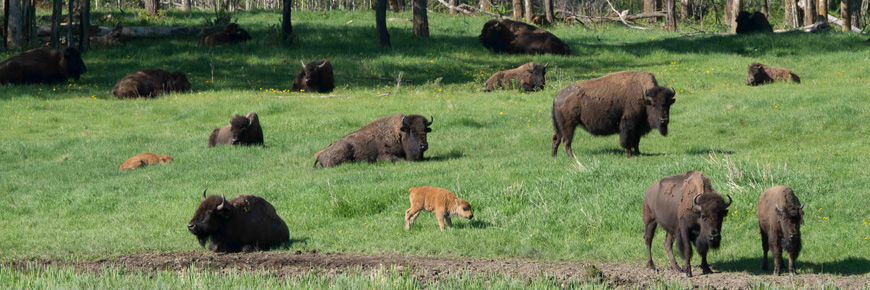
© Parks Canada / Steve Edgerton
The number of bison at Elk Island fluctuates year-to-year; there are generally around 400 plains bison and 300 wood bison. Since Elk Island is Canada’s only completely fenced national park, Parks Canada actively manages bison populations.
Why is it called Elk Island National Park when the park is famous for bison?
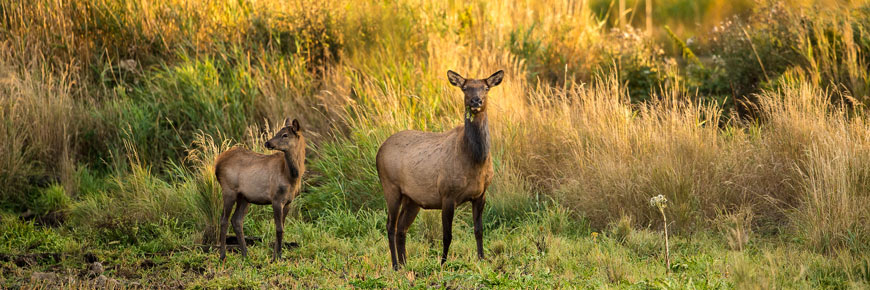
© Parks Canada / Steve Edgerton
Although as many as 500 elk may be present in the park, sometimes it can be hard to spot them as they are quite elusive. In 1906, the park was originally founded to protect one of the last remaining elk herds in the area, giving it the “Elk” of its namesake. The “island” was inspired by the islands that dot the park’s largest body of water, Astotin Lake. A year after Elk Island was founded, plains bison were reintroduced to the park when the Government of Canada purchased them from a rancher in Montana.
What is the difference between plains bison and wood bison?
Wood and plains bison are sub-species of bison, and you can find both at Elk Island National Park.
Plains Bison
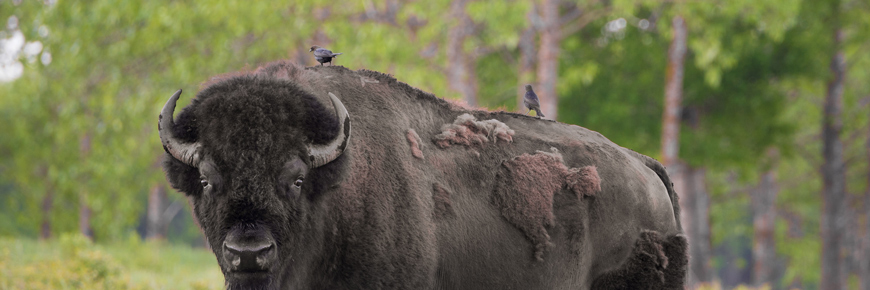
© Parks Canada / Steve Edgerton
Plains bison, or the “buffalo” of the Wild West, once dominated the Great Plains in the millions and used to roam in herds of 10,000 or 100,000 or more. Identify them by their defined shaggy “cape”, long beard, and the large, bushy hairstyle on their heads. Plains Bison have a full beard and hairy leg chaps. Their back hump is much rounder than a wood bison’s and the highest point sits directly over their front legs. Look for Elk Island’s plains bison on the north side of Highway 16.
Wood Bison
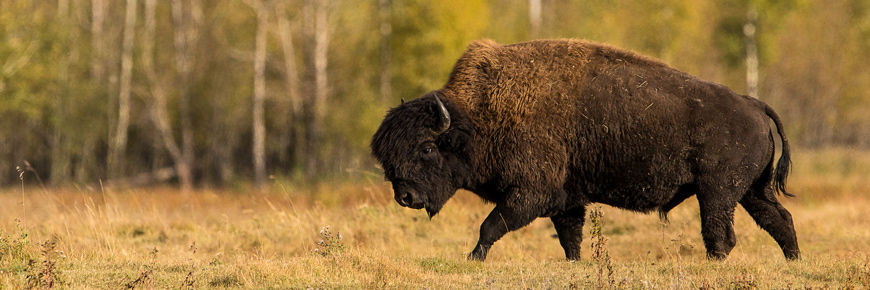
© Parks Canada / Steve Edgerton
Wood bison are adapted for the colder climate of the north as their habitat once ranged across Alaska, the North-West Territories, as well as northern Alberta and British Columbia. You can easily identify them at Elk Island as they are exclusively found on the south side of Highway 16. Compared to plains bison, wood bison are about 15-25% larger and taller, and they have longer legs, darker fur, and hair that often droops over their forehead. They have smaller, pointier beards and their legs are not as hairy as those of plains bison. Wood bison humps are tall and rectangular and the highest point of their hump sits well far forward of their shoulders.
What’s the difference between bison and buffalo?

© Parks Canada / Steve Edgerton
When you think about the “buffalo” of the Wild West, you are thinking of bison. “Bison” is the scientific name, but both “bison” and “buffalo” are used as common names for this iconic species.
The Cape Buffalo (Syncerus caffer) and Water Buffalo (Bubalus bubalis) are found in Africa and Asia respectively, while the Plains Bison (Bison bison bison) and Wood Bison (Bison bison athabascae) are native to North America. The closest living relative of these North American bison species is the European Bison or “wisent” (Bison bonasus).
How big are bison?
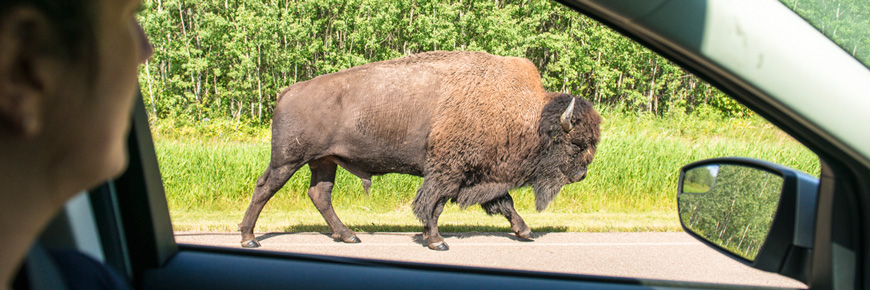
© Parks Canada
Wood bison are the largest land mammals in North America, and plains bison are not far behind. When they first emerge as calves in the spring, bison weigh 14 - 23 Kg (30 - 50 lbs) and when they are fully grown they can weigh between 680 - 1100 Kg (1500 - 2500 lbs) or about the weight of a small car. They are hard to miss!
Where can I learn more about bison?

© Parks Canada / Scott Munn
Elk Island staff are bison experts! Take part in one of the activities below to learn about Elk Island’s role in bison conservation:
- Behind the sense tours: Learn about what it takes to ensure the survival of the largest land mammal in North America in this hands-on tour of our bison handling corrals.
- The Bison Festival: Celebrate bison culture, conservation, and cuisine!
- Astotin Theatre: Hold a real bison skull, watch a documentary about Elk Island’s bison transfers, or show an interpreter your best bison photos.
Where else can I see Elk Island bison?
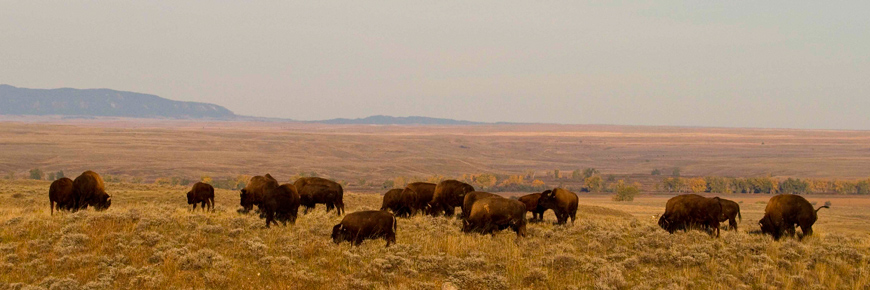
© American Prairie Reserve
Through Elk Island’s renowned bison transfer program, bison from Elk Island have helped start new herds or bolster conservation projects across their historic ranges. If you see a bison in Canada, chances are they came from Elk Island National Park at some point!
Grasslands National Park, Waterton Lakes National Park, Rocky Mountain House National Historic Site, Prince Albert National Park, and Banff National Park, among others, are all proud to protect bison that stemmed from the Elk Island bison family. Some Elk Island bison have even travelled as far as Russia and down to Montana to the American Prairie Reserve and to the Blackfeet Indian Nation.
- Date modified :